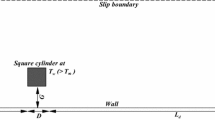Abstract
Results of physical and numerical experiments on investigating the effect of the depth of immersion of a two-dimensional obstacle with a square cross section into a developed turbulent boundary layer on the length of the separated flow region are presented. The numerical simulation is based on solving averaged Navier–Stokes equations with the use of the k–ε model of turbulence. The near-wall flow is visualized in the experiments, and the fields of mean and fluctuating velocities are measured. Flow regions where the results of numerical simulation agree with experimental data are determined. It is shown that the length of the recirculation flow region in the near wake increases with decreasing depth of immersion of the two-dimensional obstacle into the turbulent boundary layer.
Similar content being viewed by others
REFERENCES
P. S. Klebanoff and K. D. Tidstrom, “Mechanism by which a two-dimensional roughness element induces boundary-layer transition,” Phys. Fluids, 15, No. 7, 1173-1188 (1972).
W. H. Schoffeld and E. Logan, “Turbulent shear ow over surface mounted obstacles,” Trans. ASME, J. Fluids Eng., 112, 376-385 (1990).
L. J. S. Bradbury, F. Durst, B. E. Launder, F. W. Schmidt, and J. H. Whitelaw (eds.), Turbulent Shear Flows Springer-Verlag, Berlin, Heidelberg, Vol. 1 (1979); Vol. 2 (1980).
V. V. Sychev, A. I. Ruban, V. V. Sychev, and G. L. Korolev, Asymptotic Theory of Separated Flows [in Russian], Nauka, Moscow (1987).
L. V. Gogish and G. Yu. Stepanov, Separated and Cavitation Flows: Basic Properties and Numerical Models [in Russian], Nauka, Moscow (1990).
O. M. Belotserkovskii, “Numerical experiment. Direct numerical simulation of complicated ows of gas dynamics on the basis of the Euler, Navier-Stokes, and Boltzmann equations,” in: Direct Numerical Simulation of Gas Flows. Numerical Experiment in Gas Dynamics [in Russian], Nauka, Moscow (1978), pp. 6-64.
R. W. Benodekar, A. J. H. Goddard, A. D. Gosman, and R. I. Issa, “Numerical prediction of turbulent ow over surface-mounted ribs,” AIAA J., 23, 359-366 (1985).
S. Murakami and A. Mochida, “3-D numerical simulation of airow around a cubic model by means of κ-ε” model,” J. Wind Eng. Ind. Aerodyn., 31, 283-303 (1988).
D. A. Paterson and C. J. Apelt, “Simulation of ow past a cube in a turbulent boundary layer,” J. Wind Eng. Indust. Aerodyn., 35, 149-176 (1989).
A. F. Kurbatskii and S. N. Yakovenko, “Numerical investigation of the turbulent ow around a two-dimensional obstacle in the boundary layer,” Teplofiz. A_eromekh., 3, No. 2, 145-163 (1996).
O. M. Belotserkovskii and Yu. M. Davydov, Method of Coarse Particles in Gas Dynamics [in Russian], Nauka, Moscow (1982).
V. V. Larichkin, M. V. Litvinenko, and V. A. Shcherbakov, “Experimental study of the turbulent ow in the vicinity of a two-dimensional obstacle in the boundary layer,” Teplofiz. Aéromekh., 9, No. 1, 73-85 (2002).
V. I. Kornilov and D. K. Mekler, “Investigation of the memory of the turbulent boundary layer to twodimensional perturbations,” Preprint No. 32-87, Inst. Theor. Appl. Mech., Sib. Div., USSR Acad. of Sci., Novosibirsk (1987).
A. F. Kurbatskii and S. N. Yakovenko, “Diffusion of the passive admixture from a line source in the neutral atmospheric near-Earth layer,” Izv. Ross. Akad. Nauk, Fiz. Atmosf. Okeana, 35, No. 4, 506-515 (1999).
E. Logan and P. Phataraphruk, “Mean ow downstream of two-dimensional roughness elements,” Trans. ASME, J. Fluids Eng., 2, 149-153 (1989).
F. Durst and A. K. Rastogi, “Turbulent ow over two-dimensional fences,” in: Turbulent Shear Flows-2, Springer-Verlag, Berlin (1980), pp. 218-232.
A. Larousse, R. Martinuzzi, and C. Tropea, “Flow around surface-mounted, three-dimensional obstacles,” in: Turbulent Shear Flows-8, Springer-Verlag, Berlin (1993), pp. 127-139.
H. H. Nigim and D. J. Cockrell, “Effects caused by small discrete two-dimensional roughness elements immersed in turbulent boundary layers,” J. Fluid Mech., 153, 17-30 (1985).
Author information
Authors and Affiliations
Rights and permissions
About this article
Cite this article
Larichkin, V.V., Yakovenko, S.N. Effect of Boundary-Layer Thickness on the Structure of a Near-Wall Flow with a Two-Dimensional Obstacle. Journal of Applied Mechanics and Technical Physics 44, 365–372 (2003). https://doi.org/10.1023/A:1023433207192
Issue Date:
DOI: https://doi.org/10.1023/A:1023433207192




